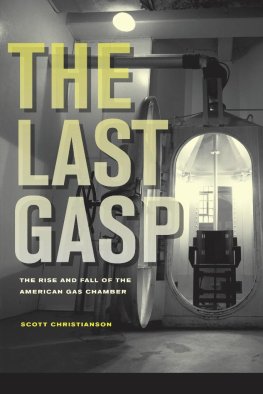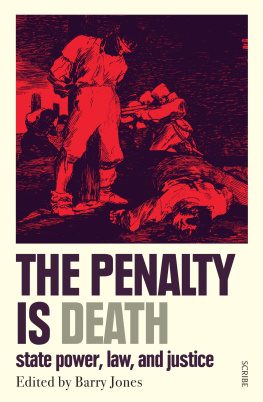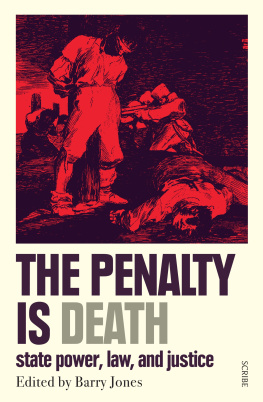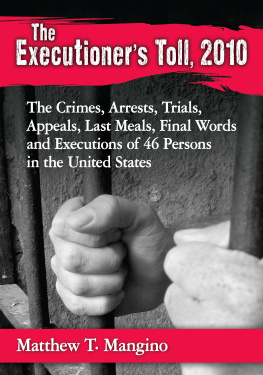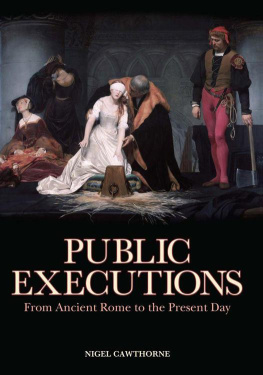ADVANCE PRAISE
Prof. Austin Sarat and his co-authors have produced a powerful indictment of state execution by lethal injection. I urge anyone interested in criminal justice, constitutional values, and in abolishing the death penalty to invest the time in reading and acting upon this important work.
U.S. Senator Chris Coons, D-Delaware and Member, Senate Judiciary Committee
This book offers compelling evidence that the promise of lethal injection is a hollow one. Sarats illuminating account shows that the situation is getting worse as states employ secrecy and obfuscation to hide their experimentation with different drugs and methods. An essential contribution.
Stephen B. Bright, former Director of the Southern Center for Human Rights
Austin Sarats trailblazing scholarship about lethal injection makes it impossible for anyone to claim that its a humane form of killing. This conscience-stirring book documents the skyrocketing of botched executions. It is a reminder of what a great teacher Sarat is.
Lincoln Caplan, Senior Research Scholar, Yale Law School
Sarat has followed the brute rituals of the death penalty in the United States for years and nowhere as powerfully as in this grim book, a cry of the heart and mind for yet another look at the botched executions inflicted by the state and the barbaric accommodations made by the courts. An exceptional, searing, and scrupulous history of ghastly murder that also gives a voice to those sacrificed on the altar of legal vengeance.
Colin Dayan, author of The Law Is a White Dog
This thorough examination of the rise and failure of lethal injection brings to mind Justice Harry Blackmuns telling declaration: I no longer shall tinker with the machinery of death. This books detailed and vivid narrative critically exposes the utter failure of the search for humane capital punishment.
Martha Minow, Harvard Law School
Sarats newest analysis of the American death penalty is part horror movie and true crime, part investigative journalism, and part social theory of policy reform. The book pulls back the curtain of the execution chamber and systematically shreds the veneer of legitimacy and humanity that has been papered over lethal injection protocols in the last few decades.
Keramet Reiter, author of 23/7
Professor Sarat paints a disturbing picture of incompetence and indifference when states inflict the extraordinary punishment of death. He powerfully documents lethal injections failures and the damage capital punishment does to all who are associated with it.
Diann Rust-Tierney, former Executive Director and Vice Chair of the National Coalition to Abolish the Death Penalty
LETHAL INJECTION AND THE FALSE PROMISE OF HUMANE EXECUTION
AUSTIN SARAT
with Mattea Denney, Greene Ko, Nicolas Graber-Mitchell, Rose Mroczka, Lauren Pelosi
stanford briefs
An Imprint of Stanford University Press
Stanford, California
Stanford University Press
Stanford, California
2022 by Austin Sarat. All rights reserved.
No part of this book may be reproduced or transmitted in any form or by any means, electronic or mechanical, including photocopying and recording, or in any information storage or retrieval system without the prior written permission of Stanford University Press.
Printed in the United States of America on acid-free, archival-quality paper
Library of Congress Cataloging-in-Publication Data available on request.
Library of Congress Control Number: 2022935885
ISBN: 9-781-5036-3353-7 (paper)
ISBN: 9-781-5036-3451-0 (ebook)
Cover design: Rob Ehle
Cover art: Shutterstock
Typeset by Classic Typography in 11/15 Adobe Garamond
CONTENTS
TO STEPHANIE FOR THE GIFT OF HER LOVE AND HER WISDOM (AS)
TO MY UNCLE, CASEY, WHOSE STORY HAS ALWAYS INSPIRED MY INTERESTS AND ASPIRATIONS (MD)
TO LARA GREY (CGM)
TO MY MOM, DAD, AND BROTHER FOR THEIR LOVE AND GUIDANCE (RM)
TO MOM, DAD, MICHAEL, LENORE, AND MY CO-COLLABORATORS (LP)
Will posterity shudder at a model of a gallows set up in complete working order on a shelf, as we of to-day shudder when we examine the ancient instruments of torture collected in the World museums? Will the American of the year of Our Lord 2,000 be so far in advance of us? We venture to hope so.
Elbridge Gerry, Alfred Southwick, and Matthew Hale, Report of the Commission to Investigate and Report the Most Humane and Practical Method of Carrying into Effect the Sentence of Death in Capital Cases (1888, 36)
The science that serves to kill so many could at least serve to kill decently. An anesthetic that would allow the condemned man to slip from sleep to death (which would be left within his reach for at least a day so that he could use it freely and would be administered to him in another form if he were unwilling or weak of will) would assure his elimination, if you insist, but would put a little decency into what is at present but a sordid and obscene exhibition.
Albert Camus, Reflections on the Guillotine (1963, 179)
How enviable a quiet death by lethal injection.
Justice Antonin Scalia, Callins v. Collins (1994, 1141)
PREFACE
As long as the United States continues to use capital punishment, scholars and commentators on public affairs should continue to write about it and highlight the damage it does to this country and its values. Even though the number of people caught up in the death penalty system is small in comparison with the numbers in jails and prisons, there is something deeply troubling about a society that kills any of its citizens no matter what they have allegedly done. That sense of trouble and its accompanying unease has drawn one of us (Austin) to this subject for a large part of his career.
But it is never clear how to approach this task in a way that feels right. We study and write about offenders, victims, and the families of both whose lives are shattered and ended by crime and punishment from a privileged distance. Research and writing in themselves cannot bridge that distance. Nothing really can.
But research and writing about the death penalty can bear witness to the killing that the state uses as criminal punishment. It helps memorialize that grim act. In doing the research for, and writing, this book we felt a strong sense of obligation to those whose lives were inevitably part of the lethal injection story. Throughout that often troubling process we also were sustained by the hope that this kind of documentary project could play a part in naming and understanding what scholars have called laws violence.
We decided to include photographs of some of the those whose executions we describe to give a human face to our subject and remind us of the real people and lives lost in the killing state. That seemed like the least we could do. All of these photos are disturbing, but readers may find one of them, a post-execution picture of Doyle Hamm, particularly so. We hope that it can help us understand what the state does in all of our names.
ONE WEEK IN THE WORLD OF LETHAL INJECTION
In April 2017, with its supply of lethal injection drugs about to expire and with thirty-two inmates still on its death row, the state of Arkansas announced that it would perform eight executions over an eleven-day period. Though legal problems ultimately halted half of them, four were carried out as originally planned. They were all conducted with a cocktail of lethal drugs that Arkansas had never before employed.
Before this execution spree, Arkansass last execution had been in 2005. For that execution, the state used the well-established, traditional three-drug lethal injection cocktail: sodium thiopental, pancuronium bromide, and potassium chloride. But the state failed to replenish its supply of those three drugs in the years that followed, and, in 2013, when Arkansas tried to buy more, it found those drugs were no longer available. This led the state to devise a new drug protocol. The protocol it came up with, however, which called for the use of lorazepam and





